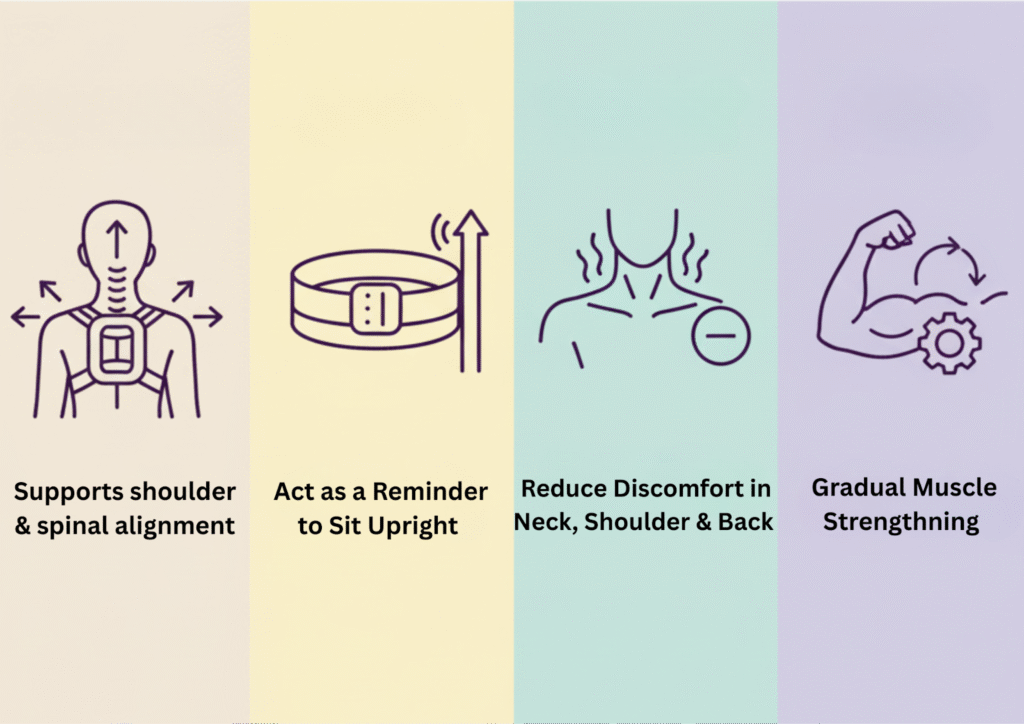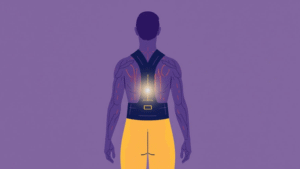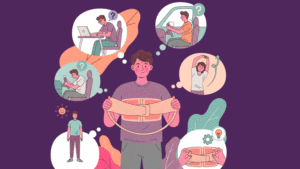You may have seen or heard about posture correction belts popping up on social media, in health gadget stores, or recommended by fitness influencers. Promises like “instant upright posture” or “wear it all day, pain-free” sound appealing, but are they true?
In this article, we’ll expose 10 of the biggest myths surrounding posture correction belts and separate fact from fiction using published research, expert insights, and clinical studies. No fluff, just clarity. Whether you’re curious about how they work or whether you should try one yourself? By the end, you’ll better understand the truth behind these devices and whether they actually live up to the hype.
The Posture Correction Belt Hype: What’s Real, What’s Not?
Before diving into myths, let’s cover what posture correction belts are supposed to where the scientific support is weak or mixed.
What Do Posture Correction Belts Claim to Do (And Why Is Everyone Talking About Them)?

Most brands promise that posture correction belts can:
- Provide external support or feedback to keep your shoulders pulled back and spine aligned.
- Serve as a reminder, sometimes through straps or vibration, to sit upright and avoid slouching.
- Reduce shoulder, neck, and back discomfort caused by poor posture.
- Gradually “train” your muscles to hold a better posture over time.
What Science Actually Says:
Research so far offers a mixed verdict on the long-term effectiveness of posture correction belts:
- Limited Evidence: According to Healthline, “little or no research supports their effectiveness,” and more studies are needed to confirm long-term benefits [1].
- Some Positive Signs: A systematic review of wearable spinal posture devices found that some tools can accurately assess and improve posture but mostly in clinical or short-term settings [2].
- Early Research: A randomized study on university students using a scapular brace showed a small improvement in shoulder alignment, but results were limited and not generalizable [3].
- Expert Opinion: Most physiotherapists agree that posture belts shouldn’t be viewed as a quick fix. They can serve as a helpful reminder, but lasting posture improvement comes from strengthening muscles, improving awareness, and regular exercise [4].
Bottom line: posture correction belts may help in certain contexts as a supplement, but they’re not a substitute for habits, movement, or a holistic approach to posture.
With that in mind, let’s bust the 10 biggest myths.
Myth #1: “Posture Correction Belts Fix Your Posture Overnight”
The claim (myth): Wear one, and your posture magically transforms overnight.
The truth (busted): Posture is a complex interplay of muscles, ligaments, and motor patterns. A belt can guide or cue alignment, but it can’t instantly rewire your neuromuscular system. In fact:
- The body needs time to learn new patterns through repetition, proprioception, and muscle strengthening.
- Studies show short-term posture change is possible with braces or supports, but the effect may not last if the device is removed. [5]
- Many correctors act as reminders, not drivers of change. Their “correction” only works while they’re worn.
Takeaway tip: Use posture belts as a support tool while you actively train your posture through exercises and awareness but don’t expect miracle overnight results.
Myth #2: “Wearing a Posture Belt Makes You Dependent on It”
The claim: If you wear it too much, your muscles will atrophy and you’ll become “addicted” to the belt.
The truth: Yes, overreliance is a risk if you let the belt do all the work, your muscles might slack off but a properly used belt supports reinforcement, not replacement.
- Experts warn that overuse may lead to decreased muscle engagement or reliance on the brace rather than your own muscles. [6]
- The correct approach is intermittent use: short intervals when posture is most challenged (e.g. long desk sessions).
- Think of the belt like training wheels: helpful early on, but you want to take them off over time.
Pro tip: Use the belt during challenging posture tasks, then gradually reduce use as your muscles strengthen.
Myth #3: “Posture Belts Are Only for People with Back Pain”
The claim: You must already be in pain to benefit from a posture correction device.
The truth: Not so. Many people use them preventively to maintain alignment, reduce strain, and manage posture fatigue even without active back pain.
Benefits of wearing a posture corrector:
- Poor posture can gradually lead to tension in shoulders, neck, and upper back even if pain hasn’t shown up yet.
- Belts can act as cues or supports to maintain awareness and reduce slouching over long work sessions.
- Some users report improved energy, less fatigue, or better breathing when posture is more open (though evidence is more anecdotal).
Myth #4: “All Posture Correction Belts Work the Same”
The claim: One belt fits all; any posture corrector will give identical results.
The truth: Not at all. There’s a wide variation in design, function, and intent.
- Some are soft fabric braces; others are rigid frameworks or smart devices with sensors.
- Features like adjustability, strap design, materials, and feedback mode (vibration, pressure) vary widely.
- Clinical research indicates that brace tension, strap arrangement, and support location influence results (e.g., scapular bracing studies).
- What works for someone with “forward shoulders” may not suit someone with lumbar slouch.
Tip for users: Choose a posture corrector matched to your weak points (shoulders, mid-back, lower spine) and lifestyle (desk, gym, general use).
Myth #5: “You Can Wear It All Day for Faster Results”
The claim: The more you wear it, the faster your posture will correct.
The truth: Overusing a posture belt can backfire, causing fatigue, discomfort, or even reduced muscle engagement.
- Experts typically recommend short intervals (30–60 minutes) and break periods without the belt. [9]
- Constant use may train your body to rely on the external support rather than engaging postural muscles.
- Correctors are intended as cues or crutches, not full-time scaffolding.
Safe practice: Use it during critical posture times (e.g., sitting, driving), then give breaks where your muscles do the work.
Myth #6: “Posture Belts Are Uncomfortable and Restrictive”
The claim: You’ll feel constrained, sweaty, or stiff the entire time.
The truth: Modern designs aim for comfort; many are breathable, lightweight, and adjustable.
- Reviews note that some newer posture correctors feel like gentle reminders rather than rigid braces. [10]
- When fitted properly, they should not pin you like a medieval corset but gently cue your alignment.
- Discomfort often comes from improper fit, overtightening, or low-quality materials.
Fit tip: When trying one, make sure you can move your arms, breathe deeply, and sit/stand without pain. If it hurts, it’s too tight for the design.
Myth #7: “They’re Only for Older People”
The claim: You’re too young, so you don’t need a posture correction belt.
The truth: In today’s screen-heavy, seated lifestyles, people of all ages, especially younger users are at risk of posture strain.
- Young professionals, students, and remote workers often develop forward-head posture and shoulder fatigue.
- Brace studies often involve young adult populations (e.g. university students in scapular brace studies) [11].
- Prevention is easier than correction; adopting healthier posture habits early helps.
Takeaway: If your job or habits foster slouching, it’s not too early to use supportive awareness tools like a well-chosen posture belt.
Myth #8: “A Posture Correction Belt Alone Can Fix Bad Posture”
The claim: Belt on → posture fixed.
The truth: A belt is just one tool in a holistic strategy. It won’t undo years of poor habits by itself.
Essential supporting moves include:
- Posture-strengthening exercises (upper back, core, scapular retractors)
- Stretching tight areas (chest, front shoulders, hip flexors)
- Ergonomics: correct desk height, chair support, screen alignment
- Movement breaks: avoid static postures, shift positions every 20–30 minutes
In short: the belt acts as a reminder or guide, but you do the real work.
Myth #9: “Posture Belts Don’t Have Any Real Health Benefits”
The claim: They’re gimmicks, with no measurable health impact.
The truth: While evidence is nascent, some benefits do appear under controlled settings:
- In scapular brace trials, wearing the brace reduced forward shoulder angle and increased muscle activation in targeted muscles. [12]
- Wearables used for spinal posture analysis have shown good accuracy in clinical settings. [13]
- Reviews of posture-correcting garments suggest potential benefit in discomfort, productivity, and posture metrics, but quality evidence is limited.
Note: Many findings are short-term, small-sample, or observational, so further research is needed to confirm long-term health benefits.
Myth #10: “Posture Correction Belts Are Just a Social Media Trend”
The claim: They’re the latest fad, soon to be forgotten.
The truth: While the recent surge in popularity is driven by social media, posture support devices have long roots in rehabilitation and ergonomics.
- Posture correctors have existed in various forms, such as braces, supports, and orthotics, for decades. [14]
- Modern wearable tech (sensors, feedback) is a new twist, not a reinvention.
- The increasing demand highlights a broader trend: people becoming more aware of sedentary risks and posture health.
So yes, the trend is hot now, but the concept of it has a clinical and ergonomic history behind it, not just clickbait.
The Science Behind Posture Correction: What Experts Actually Say
Here’s a deeper look at how braces and correctors fit into current medical thinking:
Proprioception & Feedback
One of the primary mechanisms is proprioceptive feedback. The device nudges your body toward correct alignment, making you more aware of your posture.
Over time, your brain and muscles “learn” what good posture feels like, improving your internal sense of alignment. [15]
Muscle Activation & Support
Studies like the scapular brace trial demonstrated that proper bracing can shift muscle activity (e.g. increased lower trapezius firing) and reduce forward shoulder angle. [16]
However, these benefits are often temporary or immediate effects rather than proven long-term adaptations.
Evidence Gaps & Limitations
- Many posture corrector studies focus on short-term use, not months or years.
- Sample sizes are small, and populations are often healthy (not people with severe posture issues).
- Authors caution that wearing a brace without strengthening and behavior change may yield negligible long-term benefit.
- Some critics argue that the concept of a single “ideal posture” is flawed; posture evolves with movement, age, and individual anatomy. [17]
In sum: the science supports possible benefits under certain conditions, but it does not claim posture belts as standalone cures.
How to Use a Posture Correction Belt the Right Way ?
To maximize benefits and minimize risks, apply these best practices when using a posture belt:
1. Start with a fit check
The belt should be snug but not painful. You should be able to move, breathe deeply, and sit/stand.
2. Limit wear time
Use the belt in sessions around 30–60 minutes and then remove it to let muscles work independently.
3. Combine with exercises
Pair with scapular retractions, thoracic extension work, upper back strengthening, and chest stretches.
4. Use it during high-risk posture tasks
Attach during long periods of sitting, driving, or computer use.
5. Gradually reduce reliance
As your muscles get stronger and you develop awareness, ease off belt use and trust yourself.
6. Stay dynamic
Change sitting positions, take breaks, and adjust workstation ergonomics.
Real User Results: How People (Scientifically) Got It Right?
Though we avoided anecdotal fluff, some small-sample trials and brace studies show measurable effects:
- In one office-typing simulation study, using a scapular brace led to reduced fatigue, less forward shoulder posture, and improved muscle activation over 30 minutes.
- In garment posture-correcting studies, participants wore the device for days, and metrics like spinal alignment, discomfort, and productivity showed modest improvements.
- In athletic populations, posture-support braces improved shoulder muscle control and alignment over short periods.
These controlled results suggest posture belts can assist in feedback and momentary alignment but they are most effective when combined with supporting habits.
Conclusion
Posture correction belts aren’t magic torches that instantly set your spine straight. But when used smartly, they can act like gentle cues, awareness triggers, or short-term supports. The key: don’t overuse, rely wholly on them, or expect overnight transformation. Instead, pair them with movement, exercise, and better ergonomics.
Let’s recap the truths behind the myths:
- They don’t fix posture overnight
- Don’t cause inevitable dependence if used properly
- Can help even without back pain
- Not all belts are equal
- Don’t wear them all day
- Modern designs can be comfortable
- Useful for younger users too
- They’re not a standalone fix
- They may have measurable benefits
- They’re more than just trends
If you decide to try one, choose wisely, use selectively, and use it as part of a bigger posture system. And if you ever feel discomfort or worsening pain, see a qualified physical therapist or medical professional. After all, no belt replaces a healthy, moving body.
Explore More Health & Wellness Solutions
Want to stay informed about wellness and everyday health issues? Here are some insightful reads to guide you. Explore the links below for practical tips and solutions:-
- Simple Posture Exercises to Fix Slouching and Neck Strain
- Posture Correction Belts vs Posture Braces: Which Works Best?
- Posture Corrector Belt,The Travel Hack You Didn’t Know You Needed
References
- Healthline. Retrieved May 29, 2025, Do Posture Correctors Work?. (n.d.)., from https://www.healthline.com/health/do-posture-correctors-work
- Silva, T. L. T., Ferrigno, G., Leardini, A., & Alves, J. (2019). The role of wearables in spinal posture analysis: a systematic review. BMC Musculoskeletal Disorders, 20, Article 243.https://pmc.ncbi.nlm.nih.gov/articles/PMC6368717/?utm_source=chatgpt.com
- Vijayalakshmi, T., Kumar Subramanian, S., Dharmalingam, A., Itagi, A. B. H., Mounian, S. V., & Loganathan, S. (2022). A short term evaluation of scapular upper brace on posture and its influence on cognition and behavior among adult students. Clinical Epidemiology and Global Health, 16, 101077.https://www.sciencedirect.com/science/article/pii/S2213398422001191
- Christina Rodriguez, PT, DPT, OCS, Do Posture Correctors Work? Expert advice from a PT. (2021, March 8). Hospital for Special Surgery. Retrieved from https://www.hss.edu/health-library/move-better/do-posture-correctors-work
- Leung, M., Kan, M. M. P., Cheng, H. M. H., De Carvalho, D. E., Anwer, S., Li, H., & Wong, A. Y. L. (2023). Effects of using a shoulder/scapular brace on the posture and muscle activity of healthy university students during prolonged typing — a randomized controlled cross-over trial. Healthcare, 11(11), 1555. https://doi.org/10.3390/healthcare11111555
- Sydney Physio Clinic, (2025), similarly cautions that overuse of posture braces can reduce core/back muscle work. https://www.sydneyphysioclinic.com.au/treatment-modalities/can-a-posture-brace-really-help-improve-posture/?
- Wilkes, C., Kydd, R., Sagar, M., & Broadbent, E. (2017). Upright posture improves affect and fatigue in people with depressive symptoms. Cognition and Emotion, 31(7), 1402–1410. https://doi.org/10.1080/02699931.2016.1225003
- Catherine Roberts, Senior Health & Food Reporter, (2023), Are Posture Correctors Useful? https://www.consumerreports.org/health/health-wellness/are-posture-correctors-useful-a1211785884
- Dr.Hiral Patel, (2025), ‘How long should you use a Posture Correction Belt’ https://ultracarepro.in/blogs/tips/how-long-should-you-wear-a-posture-corrector-per-day
- Saurabh Dang, MD, Interventional Pain Physician (2018), https://www.spine-health.com/treatment/alternative-care/types-back-braces-used-lower-back-pain-relief
- Leung, M., Kan, M. M., Cheng, H. M., De Carvalho, D. E., Anwer, S., Li, H., & Wong, A. Y. (2023, May). Effects of Using a Shoulder/Scapular Brace on the Posture and Muscle Activity of Healthy University Students during Prolonged Typing, A Randomized Controlled Cross-Over Trial. In Healthcare https://research.polyu.edu.hk/en/publications/effects-of-using-a-shoulderscapular-brace-on-the-posture-and-musc
- Cole, A. K., McGrath, M., & Cleland, J. A. (2004). Scapular bracing and alteration of posture and muscle activity in overhead athletes. Journal of Orthopaedic & Sports Physical Therapy, 34(12), 758-770. https://pmc.ncbi.nlm.nih.gov/articles/PMC3554027/
- Simpson, L., Maharaj, M. M., & Mobbs, R. J. (2019). The role of wearables in spinal posture analysis: A systematic review. European Spine Journal, 28(10), 2202–2215.https://pubmed.ncbi.nlm.nih.gov/30736775/
- Carini, F. (2017). Posture and posturology, anatomical and physiological fundamentals. Journal of Physical Therapy Science, 29(12), 2075–2081.https://pmc.ncbi.nlm.nih.gov/articles/PMC6166197/
- Cole, A. K., McGrath, M., & Cleland, J. A. (2004). Scapular bracing and alteration of posture and muscle activity in overhead athletes. Journal of Orthopaedic & Sports Physical Therapy, 34(12), 758-770. https://pmc.ncbi.nlm.nih.gov/articles/PMC3554027/
- Barra-López, M. E. (2024). The standard posture is a myth: A scoping review. International Journal of Environmental Research and Public Health, 21(20), 13472. https://pmc.ncbi.nlm.nih.gov/articles/PMC11492508/



















